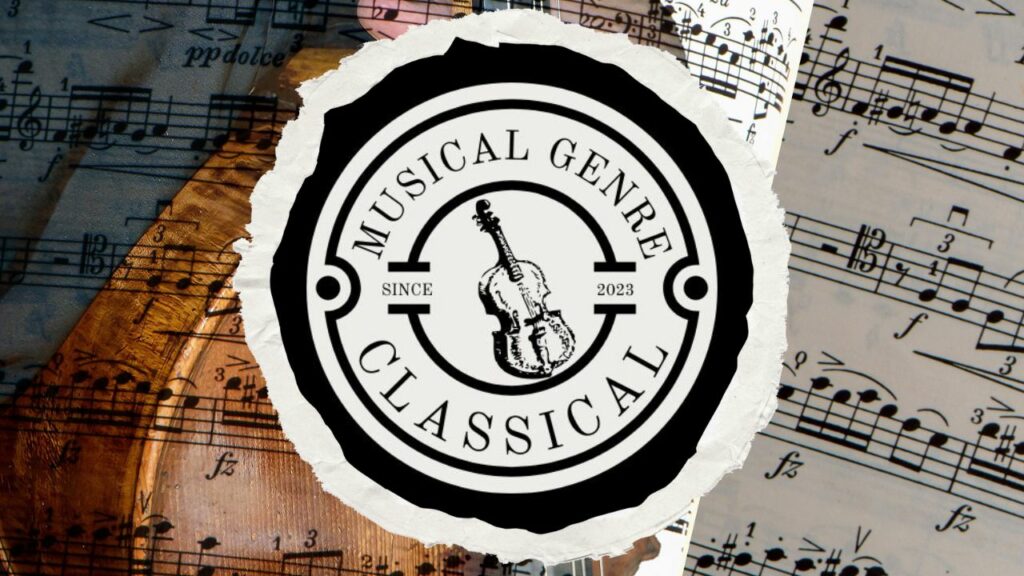
Welcome to our Top 10 countdown of Music Artists of the Classical Period. In addition to our Top 10 countdown for this subject, we have also written details Classical Period Genre Chronicles, and created classical period chronicle videos for you viewing enjoyment.
Overview of the Music Artists of the Classical Period
- Wolfgang Amadeus Mozart (1756-1791): A prolific and influential composer of the Classical era, Mozart’s work encompasses symphonies, operas, chamber music, and more. Known for his prodigious talent and timeless compositions like “Eine kleine Nachtmusik” and “The Magic Flute.”
- Ludwig van Beethoven (1770-1827): A revolutionary composer who bridged the Classical and Romantic eras, Beethoven’s compositions, such as the Ninth Symphony and “Moonlight Sonata,” express intense emotion and innovation. His deafness in later life adds a poignant layer to his story.
- Johann Sebastian Bach (1685-1750): A Baroque master, Bach’s intricate and expressive compositions include the Brandenburg Concertos and the Mass in B Minor. His counterpoint and technical mastery have left an enduring impact on classical music.
- Franz Joseph Haydn (1732-1809): Often called the “Father of the Symphony” and “Father of the String Quartet,” Haydn’s innovative contributions to these forms laid the groundwork for classical composition. His works include the “Surprise Symphony” and the “Emperor Quartet.”
- Antonio Vivaldi (1678-1741): An influential Baroque composer, Vivaldi is best known for his violin concertos, particularly “The Four Seasons.” His dynamic and vibrant compositions have left an indelible mark on the Baroque period.
- George Frideric Handel (1685-1759): A German-British Baroque composer, Handel’s masterpieces include the oratorio “Messiah” and the opera “Water Music.” His powerful and dramatic compositions have made him a central figure in Baroque music.
- Domenico Cimarosa (1749-1801): An Italian composer known for his operas, Cimarosa’s light and melodic style contributed to the late 18th-century opera buffa tradition. His comic operas, such as “Il matrimonio segreto,” are particularly acclaimed.
- Giovanni Battista Viotti (1755-1824): An Italian violinist and composer, Viotti’s virtuosity on the violin earned him acclaim in the late 18th century. He is recognized for his violin concertos and contributions to the development of the classical violin style.
- Franz Xaver Süssmayr (1766-1803): An Austrian composer and pupil of Mozart, Süssmayr is best known for completing Mozart’s unfinished “Requiem.” While not as prolific as some of his contemporaries, his role in completing the Requiem has preserved Mozart’s legacy.
- Maria Theresia von Paradis (1759-1824): An Austrian composer and pianist, Paradis lost her sight as a child but became a prominent musician in Vienna. Her compositions, including piano music and lieder, reflect the elegance and grace of the Classical period.
Top 10 Countdown of the Music Artists of the Classical Period
10 – Maria Theresia von Paradis (1759-1824)
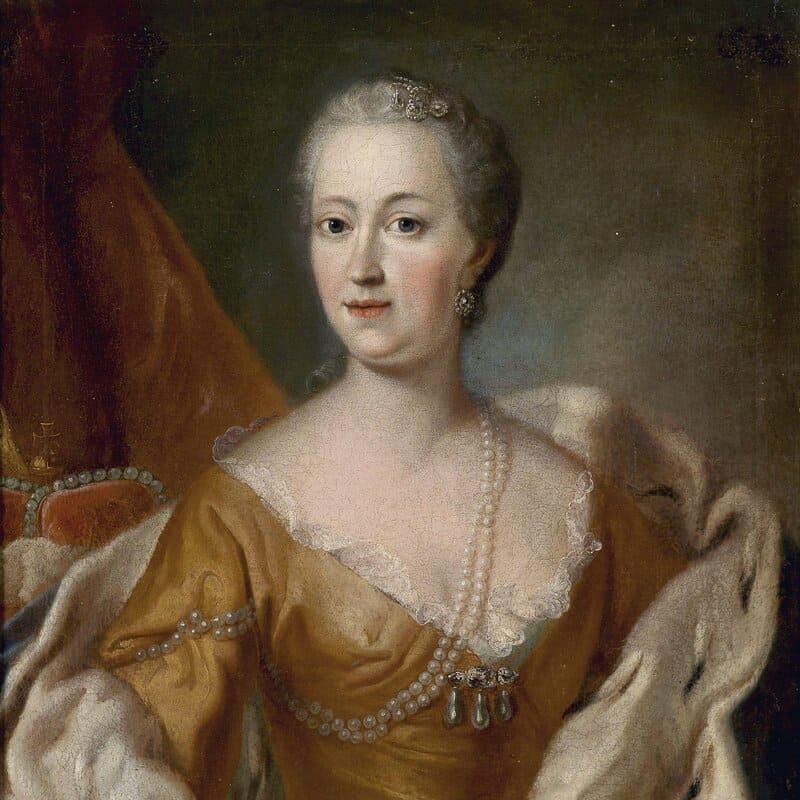
Maria Theresia von Paradis was born on May 15, 1759, in Vienna, Austria. A gifted musician, she lost her sight at an early age but went on to become a notable composer and pianist during the Classical period.
Ten Interesting Facts about Maria Theresia von Paradis:
- Blind Prodigy: Maria Theresia von Paradis lost her sight at three, but this did not hinder her musical talent. She started playing the piano at a young age and was recognized as a child prodigy.
- Pupil of Salieri: She studied under composer Antonio Salieri, a prominent figure in Viennese musical circles. Salieri recognized her exceptional abilities and contributed to her musical education.
- Versatile Composer: Paradis composed for various genres, including piano music, lieder (German art songs), and chamber music. Her compositions, characterized by elegance and lyricism, gained popularity in 18th-century Vienna.
- Concert Tours: Paradis embarked on successful concert tours across Europe, showcasing her exceptional piano skills. Her performances were praised for their emotional depth and technical brilliance.
- Close Association with Mozart: She had a close friendship with Wolfgang Amadeus Mozart, and there were rumors of a possible romantic connection. However, the nature of their relationship remains a historical mystery.
- Court Musician: Paradis served as a court musician for the Habsburgs, earning recognition for her contributions to Viennese musical culture. Her performances were attended by aristocrats and influential figures of the time.
- Advocate for Blind Musicians: She advocated for the inclusion of blind musicians in society, challenging stereotypes and paving the way for future visually impaired artists.
- Published Composer: Paradis published her compositions, contributing to the body of work by female composers in a predominantly male-dominated musical landscape.
- Influence on Beethoven: Beethoven admired Paradis’s talent and featured her improvisations in his compositions. The two shared a mutual respect for each other’s musical abilities.
- Later Life and Legacy: Paradis faced financial difficulties later in life and withdrew from public performances. Despite her challenges, she left a lasting impact on the history of classical music, inspiring future generations of musicians.
Conclusion:
Maria Theresia von Paradis, despite facing the adversity of blindness, triumphed as a remarkable composer and pianist in 18th-century Vienna. Her legacy extends beyond her compositions, as she played a crucial role in challenging societal norms and advocating for the inclusion of visually impaired musicians. Paradis’s contributions to classical music history remain a testament to the resilience and artistic prowess of individuals overcoming physical challenges.
9 – Franz Xaver Süssmayr (1766-1803)
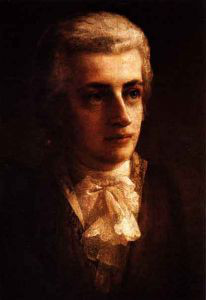
Franz Xaver Süssmayr was born on February 29, 1766, in Schwanenstadt, Austria. A composer and pupil of Wolfgang Amadeus Mozart, he is best known for completing Mozart’s unfinished “Requiem.”
Ten Interesting Facts for Franz Xaver Süssmayr:
- Mozart’s Protégé: Süssmayr became a pupil of Mozart in his teenage years, studying composition and forming a close mentor-student relationship with the renowned composer.
- Completion of the “Requiem”: Following Mozart’s death in 1791, Süssmayr was entrusted with the task of completing Mozart’s final masterpiece, the “Requiem.” His contribution to finishing the composition solidified his place in musical history.
- Collaboration with Mozart: Süssmayr collaborated with Mozart on several works, including operas and choral compositions. This collaboration played a crucial role in shaping Süssmayr’s own compositional style.
- Versatility in Composition: Beyond completing Mozart’s works, Süssmayr composed symphonies, chamber music, and operas. His compositions, while not as well-known as Mozart’s, showcase a skilled and versatile composer.
- Viennese Musical Scene: Süssmayr was an active participant in the vibrant musical scene of Vienna during the late 18th century. His works were performed in the city’s esteemed concert halls and theaters.
- Influence on later composers: Süssmayr’s contributions to completing Mozart’s “Requiem” influenced later composers who attempted to finish incomplete works of their predecessors, demonstrating his impact on the tradition of musical completion.
- Choral Works: He excelled in composing choral works, and his Masses and oratorios received acclaim for their intricate choral writing and expressive qualities.
- Relationship with Constanze Mozart: Süssmayr maintained a close relationship with Constanze Mozart, Wolfgang’s widow, providing support and assistance during challenging times.
- Teaching Career: In addition to his compositional endeavors, Süssmayr pursued a career as a music teacher, sharing his knowledge and expertise with the next generation of musicians.
- Legacy and Posthumous Recognition: Süssmayr’s legacy primarily rests on his completion of Mozart’s “Requiem,” a task he carried out with dedication and skill. While not as celebrated as some contemporaries, his role in preserving and extending Mozart’s musical heritage remains significant.
Conclusion:
Franz Xaver Süssmayr’s life and career were deeply intertwined with the legacy of Wolfgang Amadeus Mozart. His completion of the “Requiem” stands as a testament to his loyalty, musical skill, and the collaborative nature of classical composition in the late 18th century. Süssmayr’s contributions, though overshadowed by Mozart’s brilliance, remain a valuable chapter in the history of classical music.
8. Giovanni Battista Viotti (1755-1824)
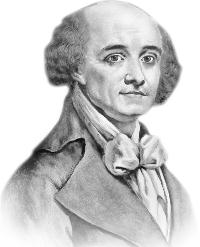
Giovanni Battista Viotti was born on May 12, 1755, in Fontanetto Po, Kingdom of Sardinia. Renowned as an Italian violinist and composer, Viotti’s virtuosity on the violin and his significant contributions to the development of classical violin style earned him acclaim.
Ten Interesting Facts about Giovanni Battista Viotti:
- Early Prodigy: Viotti displayed exceptional musical talent from an early age, receiving violin lessons from his father. By his teenage years, he had already established a reputation as a prodigious violinist.
- Concertmaster in Turin: Viotti’s career took off when he became the concertmaster of the Royal Theatre of Turin. His skillful performances and compositions began to draw attention throughout Europe.
- Parisian Success: He achieved great success in Paris, where his concerts were met with enthusiasm and admiration. Viotti’s performances contributed to the rising popularity of the violin as a solo instrument.
- Friendship with Mozart: Viotti’s time in Paris coincided with Wolfgang Amadeus Mozart’s visits to the city. The two composers developed a friendship, and Mozart even dedicated a set of quartets to Viotti.
- Innovations in Violin Technique: Viotti’s playing style and compositions significantly influenced the development of violin technique during the late 18th century. His use of expressive and virtuosic elements set new standards for violin performance.
- London Years: Viotti spent a considerable part of his career in London, where he became a central figure in the city’s musical scene. His concerts were major events, attracting audiences with his brilliant violin playing.
- Opera Compositions: In addition to his success as a violinist, Viotti composed several operas, blending Italian and French operatic traditions. His operas, such as “L’Olimpiade,” were well-received during his time.
- Financial Setbacks: Despite his musical successes, Viotti faced financial difficulties, partly due to the expenses of his lavish lifestyle. Financial setbacks led him to declare bankruptcy, affecting his later years.
- Return to Paris: Viotti returned to Paris in the early 19th century, where he continued to perform and compose. However, changing musical tastes and personal challenges affected the reception of his later works.
- Legacy in Violin Music: Giovanni Battista Viotti’s legacy endures in the realm of violin music. His compositions, including violin concertos and chamber music, continue to be studied and performed, showcasing his lasting impact on classical violin repertoire.
Conclusion:
Giovanni Battista Viotti’s influence on the development of violin technique and his contributions to the world of classical music, both as a performer and composer, remain significant. Despite facing financial hardships later in life, Viotti’s legacy lives on through his innovative approach to the violin and his lasting impact on the classical music landscape of the late 18th and early 19th centuries.
7 – Domenico Cimarosa (1749-1801)
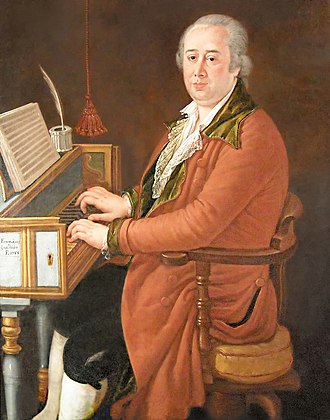
Domenico Cimarosa was born on December 17, 1749, in Aversa, Kingdom of Naples (now Italy). A prominent Italian composer of the late 18th century, Cimarosa is best known for his contributions to opera buffa, the comedic opera style popular during his time.
Ten Interesting Facts about Domenico Cimarosa:
- Prolific Opera Composer: Cimarosa’s fame primarily rests on his operatic compositions, with over 80 operas to his name. His works, such as “Il matrimonio segreto” (The Secret Marriage), were celebrated for their wit and melodic richness.
- Neapolitan Conservatory: Cimarosa received his musical education at the Santa Maria di Loreto Conservatory in Naples, where he excelled in composition and keyboard playing.
- Rise to Prominence: His breakthrough came with the opera “Le pazzie di Stelladaura e di Zoroastro,” which gained widespread acclaim. Cimarosa’s ability to blend humor with musical sophistication contributed to the popularity of opera buffa.
- Court Composer: Cimarosa served as a court composer for Catherine II of Russia, composing several operas for the Russian imperial court. However, his time in Russia was marred by political intrigues, leading to his imprisonment and eventual release.
- Return to Italy: After his release from Russia, Cimarosa returned to Italy, where he continued to compose operas. Despite the challenges he faced, his works continued to captivate audiences.
- Style and Influence: Cimarosa’s operas are characterized by lively and expressive melodies, intricate ensembles, and a keen sense of theatricality. His influence extended beyond Italy, impacting the operatic traditions of other European countries.
- Collaboration with Lorenzo Da Ponte: Cimarosa collaborated with librettist Lorenzo Da Ponte, known for his work with Mozart. Together, they created the opera “Il matrimonio segreto,” which became one of Cimarosa’s most famous and enduring works.
- Operatic Reforms: Cimarosa played a role in the reform of operatic conventions, contributing to the evolution of opera buffa. His emphasis on character development and engaging storytelling influenced the direction of comedic opera.
- Final Years in Venice: In his later years, Cimarosa lived in Venice, where he continued to compose and contribute to the city’s musical scene. His compositions during this period include operas and chamber music.
- Legacy and Revival: While Cimarosa’s works experienced a decline in popularity after his death, the 20th century witnessed a revival of interest in his operas. “Il matrimonio segreto” remains a staple in the operatic repertoire.
Conclusion:
Domenico Cimarosa’s impact on the world of opera buffa was profound, shaping the comedic opera genre during a pivotal period in the late 18th century. Despite facing personal and political challenges, Cimarosa’s contributions to Italian opera and his ability to infuse humor with musical sophistication secured his place in the history of classical music. His legacy endures through the ongoing appreciation of his operas, especially “Il matrimonio segreto,” which continues to delight audiences with its wit and charm.
6 – George Frideric Handel (1685-1759)
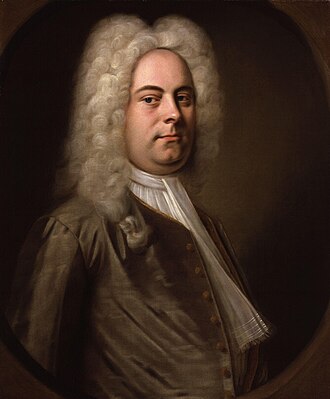
George Frideric Handel was born on February 23, 1685, in Halle, Duchy of Magdeburg (now Germany). A German-British Baroque composer, Handel is renowned for his operas, oratorios, and instrumental compositions, leaving an indelible mark on Baroque music.
Ten Interesting Facts George Frideric Handel:
- Early Musical Education: Handel showed early musical talent, receiving training in Halle and later studying law at the University of Halle. However, his passion for music led him to pursue a career as a composer.
- Move to Italy: Handel traveled to Italy, where he immersed himself in the operatic and choral traditions. His time in Italy greatly influenced his compositional style, particularly in the realm of opera.
- Operatic Success in London: Handel moved to London, where he achieved considerable success as an opera composer. Works like “Rinaldo” and “Giulio Cesare” captivated audiences with their melodic richness and dramatic flair.
- Transition to Oratorios: With the decline of Italian opera’s popularity in London, Handel transitioned to composing English oratorios. “Messiah” is one of his most famous oratorios, known for its Hallelujah chorus and widespread acclaim.
- Royal Patronage: Handel enjoyed the patronage of the British royal family, notably King George II. This support allowed him to establish the Royal Academy of Music, further solidifying his position as a central figure in London’s musical scene.
- Water Music and Music for Royal Fireworks: Handel composed festive orchestral suites like “Water Music” and “Music for the Royal Fireworks” for open-air performances, showcasing his ability to create music for grand public events.
- Hallelujah Chorus Tradition: The tradition of standing during the Hallelujah chorus in “Messiah” is said to have originated from a belief that King George II stood during its premiere. This tradition continues in many performances of the oratorio.
- Blindness and Resurgence: In the last years of his life, Handel experienced declining health, including a gradual loss of vision. Despite these challenges, he continued to compose, and his oratorios from this period, such as “Jephtha,” are testament to his resilience.
- Legacy of “Messiah”: “Messiah” remains one of the most performed and beloved oratorios in the classical repertoire. The Hallelujah chorus, in particular, has become a cultural icon and is often performed in various contexts beyond classical music.
- Death and Burial at Westminster Abbey: Handel passed away on April 14, 1759, and was buried in Westminster Abbey, a testament to his revered status in British musical history.
Conclusion:
George Frideric Handel’s legacy is synonymous with the grandeur of Baroque music, from his early success in Italian opera to his later triumphs in English oratorio. His ability to adapt to changing musical tastes, coupled with his prolific output, secured his place as one of the greatest composers of the Baroque era. Handel’s impact is not only heard in concert halls but resonates in cultural traditions, with the Hallelujah chorus remaining an enduring symbol of his contribution to the world of classical music.
5 – Antonio Vivaldi (1678-1741)
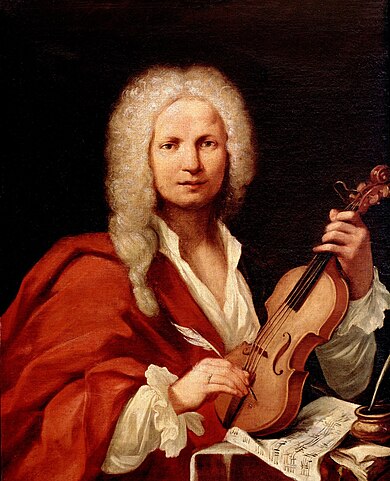
Antonio Vivaldi was born on March 4, 1678, in Venice, Republic of Venice (now Italy). A Baroque composer and virtuoso violinist, Vivaldi is best known for his innovative compositions, with “The Four Seasons” standing as one of the most iconic works in the classical repertoire.
Ten Interesting Facts about Antonio Vivaldi:
- Red Priest: Vivaldi was nicknamed the “Red Priest” due to his red hair and his ordination as a Catholic priest. Despite his religious vocation, much of his life was devoted to music.
- Ospedale della Pietà: Vivaldi spent a significant part of his career as a violin teacher and conductor at the Ospedale della Pietà, an orphanage in Venice. The institution was renowned for its excellent music program.
- Concerto Innovations: Vivaldi made significant contributions to the concerto form, particularly the solo concerto. His compositions featured virtuosic violin parts, showcasing his own skill as a violinist.
- “The Four Seasons”: This set of four violin concertos, each representing a season, is perhaps Vivaldi’s most famous work. The innovative use of programmatic elements and vivid musical imagery make it a landmark in Baroque music.
- Rediscovery in the 20th Century: Vivaldi’s music experienced a revival in the 20th century after years of relative obscurity. His works, once nearly forgotten, became central to the Baroque music revival.
- Influence on Bach: Johann Sebastian Bach was influenced by Vivaldi’s music, and Bach transcribed several of Vivaldi’s concertos for keyboard instruments. This exchange of musical ideas between the two composers is a fascinating aspect of Baroque music history.
- Operatic Output: Vivaldi composed numerous operas, contributing to the Venetian operatic tradition. His operas, including “Orlando furioso” and “La Griselda,” were popular in their time.
- Controversial Departure from Ospedale della Pietà: Despite his success at the Ospedale, Vivaldi’s departure in 1740 was marked by controversy. Some speculate it was due to conflicts with the administration, while others attribute it to changes in musical taste.
- Financial Struggles: Vivaldi faced financial difficulties throughout his life, despite his musical achievements. He often relied on commissions, patronage, and the sales of his compositions to support himself.
- Legacy in Baroque Music: Vivaldi’s impact on Baroque music extends beyond his famous concertos. His compositions, characterized by their rhythmic vitality, expressive melodies, and innovative use of orchestration, continue to influence musicians and captivate audiences.
Conclusion:
Antonio Vivaldi’s legacy is inseparable from the vibrancy and inventiveness of Baroque music. His groundbreaking contributions to the concerto form, the rediscovery of his works in the 20th century, and the enduring popularity of “The Four Seasons” have solidified his position as a pivotal figure in the history of classical music. Vivaldi’s influence reaches not only through his compositions but also through the ripple effect of his ideas on later composers and the broader Baroque music tradition.
4 – Franz Joseph Haydn (1732-1809)
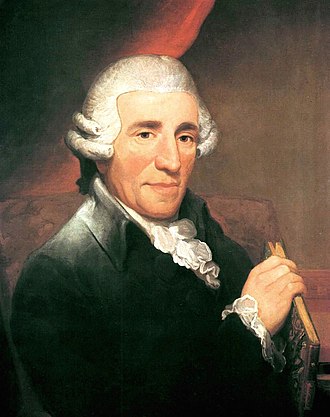
Franz Joseph Haydn was born on March 31, 1732, in Rohrau, Austria. Often referred to as the “Father of the Symphony” and the “Father of the String Quartet,” Haydn was a leading figure in the Classical period and a prolific composer who significantly shaped the development of classical music.
Ten Interesting Facts about Franz Joseph Haydn :
- Esterházy Patronage: Haydn spent the majority of his career as the court composer for the Esterházy family, where he produced an extensive body of work. His long association with the Esterházys allowed him the freedom to experiment and innovate.
- Symphony No. 94, “Surprise”: Haydn’s Symphony No. 94 is famously known as the “Surprise Symphony” due to its unexpected loud chord in the second movement. This humorous touch is emblematic of Haydn’s wit and playfulness in composition.
- String Quartet Innovations: Haydn’s contributions to the string quartet genre were groundbreaking. His Op. 33 quartets, nicknamed the “Russian” quartets, marked a shift in the structure and character of the string quartet.
- London Symphonies: Haydn’s two visits to London in the 1790s were immensely successful. The symphonies he composed during this period, known as the “London Symphonies,” contributed to the development of the symphonic form.
- Influence on Mozart and Beethoven: Haydn’s influence extended to his younger contemporaries, including Wolfgang Amadeus Mozart and Ludwig van Beethoven. The three composers are often referred to as the “Viennese School,” and Haydn’s mentorship had a profound impact on Mozart and Beethoven’s development as composers.
- Creation of the Classical Symphony: Haydn played a crucial role in the evolution of the symphony. He developed the classical symphonic form, which typically consists of four movements, with the first movement often featuring a sonata-allegro structure.
- “Farewell” Symphony: Composed for the Esterházy court, Haydn’s Symphony No. 45 is known as the “Farewell Symphony.” In the final movement, musicians gradually leave the stage, symbolizing the musicians’ desire to return home after a long stay at the summer palace.
- Chamber Music and Keyboard Works: In addition to symphonies and quartets, Haydn excelled in chamber music and keyboard works. His piano sonatas and trios, among other compositions, showcase his mastery of these forms.
- Personal Life and Personality: Haydn was known for his amiable personality and sense of humor. He had a close friendship with Mozart, and their letters reveal a warm and humorous exchange of ideas.
- Legacy and Musical Contributions: Haydn’s influence on classical music is immeasurable. His innovations in form, harmonic language, and orchestration laid the groundwork for the Classical period and set the stage for the Romantic era that followed.
Conclusion:
Franz Joseph Haydn’s impact on classical music cannot be overstated. His inventive spirit, coupled with a deep understanding of form and structure, shaped the symphonic and chamber music genres. As a central figure in the Viennese School, Haydn’s legacy endures not only in the body of his own work but also in the profound influence he had on subsequent generations of composers, making him a cornerstone of classical music history.
3 – Johann Sebastian Bach (1685-1750)
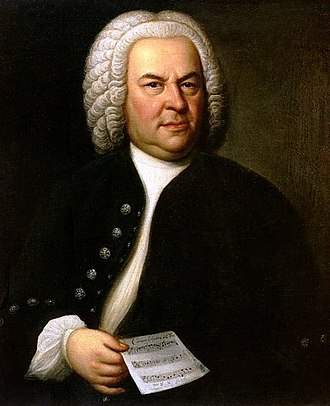
Johann Sebastian Bach was born on March 21, 1685, in Eisenach, Duchy of Saxe-Eisenach (now Germany). A towering figure of the Baroque era, Bach was a prolific composer and musician whose works are celebrated for their complexity, depth, and spiritual resonance.
Ten Interesting Facts about Johann Sebastian Bach:
- Musical Family: Bach hailed from a renowned musical family, with several generations of musicians. His father, Johann Ambrosius Bach, and uncles were musicians, laying the foundation for Bach’s early exposure to music.
- Organ Virtuoso: Bach was an exceptional organist. His skills as a virtuoso organist were widely recognized during his lifetime, and he held various positions as a church organist and court musician.
- Compositions for Every Instrument: Bach composed extensively for a wide range of instruments. His catalog includes masterpieces for keyboard instruments, orchestras, choirs, and solo instruments. His works for solo violin and cello, such as the Sonatas and Partitas, remain iconic.
- “Brandenburg Concertos”: Bach’s set of six orchestral works known as the “Brandenburg Concertos” is considered a pinnacle of Baroque instrumental composition. Each concerto explores unique combinations of instruments, showcasing Bach’s inventive genius.
- St. Matthew Passion and Other Oratorios: Bach’s oratorios, particularly the St. Matthew Passion, represent monumental achievements in choral and vocal music. These compositions are profound expressions of faith and spirituality.
- Cantatas: Bach composed over 200 sacred and secular cantatas. These short choral works, often performed in Lutheran church services, demonstrate his mastery of counterpoint and intricate vocal writing.
- Musical Pedagogue: In addition to his compositional output, Bach was a dedicated teacher. He held positions as the Thomaskantor in Leipzig, where he not only directed music but also taught at the St. Thomas School.
- Well-Tempered Clavier: Bach’s “Well-Tempered Clavier” consists of two sets of preludes and fugues in all major and minor keys. This work is a cornerstone of keyboard literature and showcases Bach’s exploration of tuning systems.
- Personal Tragedies: Bach faced personal tragedies, including the loss of his first wife and children. Despite these hardships, his music often reflects a profound sense of hope, faith, and resilience.
- Legacy and Rediscovery: Bach’s music fell into relative obscurity after his death, but a revival of interest in the 19th century led to the recognition of his unparalleled contributions. His music became foundational for subsequent composers, and his influence extends to diverse genres.
Conclusion:
Johann Sebastian Bach’s musical legacy is marked by an unrivaled synthesis of technical mastery and profound emotion. His compositions, spanning a vast array of genres and instruments, showcase a depth of expression that has resonated through the centuries. Bach’s ability to combine intellectual rigor with deep spirituality has left an indelible mark on Western classical music, solidifying his place as one of the greatest composers in history.
2 – Ludwig van Beethoven (1770-1827)
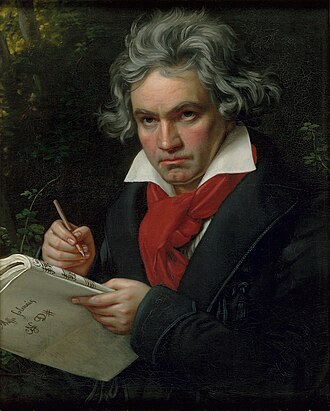
Ludwig van Beethoven was born on December 16, 1770, in Bonn, Electorate of Cologne (now Germany). A pivotal figure in the transition from the Classical to the Romantic era, Beethoven’s compositions are celebrated for their emotional intensity, innovation, and profound impact on the course of Western classical music.
Ten Interesting Facts about Ludwig van Beethoven:
- Deafness and Triumph Over Adversity: Beethoven began to lose his hearing in his late twenties, a devastating blow for a musician. Despite this, he continued to compose some of his most groundbreaking works, including the Ninth Symphony, while completely deaf.
- Bridge Between Classical and Romantic Eras: Beethoven’s music is often regarded as a bridge between the Classical and Romantic periods. His compositions expanded the boundaries of classical forms and paved the way for the emotional expressiveness of the Romantic era.
- Heroic Period: Beethoven’s middle period, often referred to as the “Heroic Period,” produced some of his most famous works, including the Third Symphony, “Eroica,” and the Fifth Symphony. These compositions reflect his admiration for heroic ideals and a break from traditional symphonic conventions.
- “Ninth Symphony” and the Ode to Joy: Beethoven’s Ninth Symphony, with its final movement featuring the “Ode to Joy,” is a monumental work that includes a choir and vocal soloists. It is a celebration of universal brotherhood and remains one of the most iconic pieces in the classical repertoire.
- Piano Sonatas: Beethoven’s 32 piano sonatas are a testament to his evolution as a composer. They showcase his experimentation with form, structure, and harmonic language. The “Moonlight Sonata” and the “Appassionata” are among the most famous.
- String Quartets: Beethoven’s late string quartets, particularly the “Late Quartets,” are considered some of the most profound and innovative chamber music ever composed. They explore new realms of expression, pushing the boundaries of what was thought possible in the genre.
- Revolutionary Artistic Vision: Beethoven viewed his art as a means of personal expression and often inserted his own voice into his works. This revolutionary approach to music composition laid the foundation for the Romantic ethos of the artist as an individual with a unique voice.
- Patronage and Financial Struggles: Unlike some of his predecessors, Beethoven struggled with financial difficulties throughout his life. Despite receiving patronage from aristocrats, he faced numerous financial challenges, often exacerbated by his increasing deafness.
- Immortal Beloved: Beethoven’s personal life remains shrouded in mystery, particularly his relationships. The identity of his “Immortal Beloved,” a term used in a passionate love letter, is still a subject of speculation and debate among historians and musicologists.
- Legacy and Impact: Beethoven’s impact on music cannot be overstated. His legacy extends beyond classical music into popular culture, with his compositions frequently featured in films, advertisements, and other media. His influence on subsequent composers, including Romantic giants like Brahms and Wagner, is profound.
Conclusion:
Ludwig van Beethoven’s life and work represent a revolutionary force in the history of music. His ability to transcend personal adversity and create music that speaks to the depths of the human experience has made him an enduring icon. Beethoven’s groundbreaking compositions and his commitment to artistic innovation have left an indelible mark on the trajectory of classical music, making him one of the most celebrated and influential composers of all time.
1 – Wolfgang Amadeus Mozart (1756-1791)
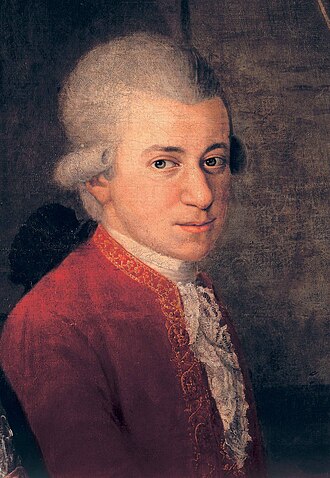
Wolfgang Amadeus Mozart was born on January 27, 1756, in Salzburg, Archbishopric of Salzburg (now Austria). A child prodigy and one of the greatest composers in the history of Western classical music, Mozart’s contributions spanned nearly every genre of his time, leaving an extraordinary legacy.
Ten Interesting Facts about Wolfgang Amadeus Mozart:
- Child Prodigy: Mozart demonstrated exceptional musical talent from a very young age. By the age of five, he was already proficient in playing the keyboard and violin, and he began composing original music.
- Prolific Composer: Mozart’s catalog includes over 600 compositions, ranging from symphonies and operas to chamber music and choral works. His ability to compose with remarkable speed and precision is legendary.
- Operatic Masterpieces: Mozart’s operas, such as “The Marriage of Figaro,” “Don Giovanni,” and “The Magic Flute,” are considered masterpieces. He brought a new level of emotional depth and psychological complexity to the operatic form.
- Piano Concertos: Mozart’s piano concertos, including the vibrant and expressive Concerto No. 21 in C major (“Elvira Madigan”), are celebrated for their balance of virtuosity and lyricism.
- Friendship with Haydn: Mozart developed a close friendship with Franz Joseph Haydn, another influential composer of the Classical period. They admired each other’s work, and Haydn’s influence is evident in Mozart’s later compositions.
- Vienna Years: Mozart spent a significant portion of his career in Vienna, where he established himself as a prominent musician and composer. Vienna was a center of musical activity during the late 18th century, and Mozart thrived in its vibrant cultural environment.
- Mysterious Death: Mozart’s death at the age of 35 has been the subject of much speculation and mystery. The exact cause of his death, attributed to severe illness, remains uncertain.
- Compositions for Freemasonry: Mozart was a Freemason, and his association with the Masonic order is reflected in some of his compositions, including the opera “The Magic Flute.” Masonic symbolism and themes are woven into the narrative.
- Financial Struggles: Despite his musical success, Mozart faced financial difficulties throughout his life. He often lived beyond his means, and his financial struggles were exacerbated by his generosity and love for a lavish lifestyle.
- Legacy and Influence: Mozart’s music is characterized by its clarity, elegance, and emotional depth. His work laid the foundation for the Classical style and influenced subsequent generations of composers, including Beethoven and many Romantic-era musicians.
Conclusion:
Wolfgang Amadeus Mozart’s extraordinary musical talent, versatility, and prolific output make him an undisputed giant in the history of classical music. His ability to seamlessly blend beauty with technical brilliance, coupled with his profound influence on the development of musical forms, solidifies his status as one of the greatest composers of all time. Mozart’s music continues to captivate audiences worldwide, and his enduring legacy is a testament to the timeless power of his artistic contributions.
Visit our Classical Period Chronicles to read more detail about each composer, in an exciting story format, or enjoy another Top 10 countdown.
